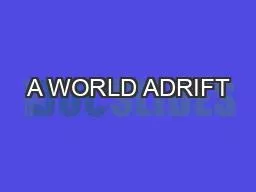

112In 2040 the international system is directionless chaotic and volatile as international rules and institutions are largely ignored by major powers such as China regional players and nonstate Cooper ID: 891034
Download Pdf The PPT/PDF document "A WORLD ADRIFT" is the property of its rightful owner. Permission is granted to download and print the materials on this web site for personal, non-commercial use only, and to display it on your personal computer provided you do not modify the materials and that you retain all copyright notices contained in the materials. By downloading content from our website, you accept the terms of this agreement.
1 112 A WORLD ADRIFT I n 2040, the interna
112 A WORLD ADRIFT I n 2040, the international system is directionless, chaotic, and volatile as international rules and institutions are largely ignored by major powers such as China, regional players, and nonstate Cooperation and Development (OECD) countries are plagued by slower economic growth, widening societal divisions, and political paralysis. China is taking advantage of the West’s troubles to expand its international the will and military might to take on global leadership, leaving many global challenges, such as climate change and instability in developing countries, largely unaddressed. HOW WE GOT THERE Many of the world’s advanced and emerging market economies never fully recovered from the COVID-19 pandemic, which was prolonged by a 2020s, high national debt, the costs of caring for aging populations, and repeated climate events strained government budgets and crowded out other spending priorities, like education, infra - - ment. Environmental, health, and economic crises had emerged gradually and sporadically over the decade, limiting political support and resources for governments to take action beyond emer - gency relief and short-term economic stimulus. Economic hardships widened societal divisions and made it harder to reach political compromise on domestic and national security priorities. Public frustrations and protests grew in many countries, but fragmented and competing oppo - sition movements were unable to agree on clear demands and goals. Polarized societies, shaped by social media, led to more political deadlock and wild policy swings. These factionalized com - munities, primarily in democratic countries, were the environment, migration, and foreign policy. Uncertainty surrounding crises and erratic gov - ernment responses suppressed investment and into a period of sluggish growth that many lik - ened to Japan’s “lost decade” in the 1990s. Devel - oping countries stagnated, with some turning to - Photo / Bigstock GLOBAL TRENDS 113 larly in Africa and the Middle East. International challenges festered, ranging from terrorism to declining human development. Waves of mi - economic decline and sought entry to wealthier countries in Europe, Asia, and North America. During this period, China experienced many of the same environmental and societal problems but was better able to adapt because of stronger social cohesion and trust; agile direction from centralized authority; a proven ability to deliver that repressed competing voices. Although to a lesser degree than the growth in the boom years of the 1990s and 2000s, domestic demand generated gross domestic product (GDP) growth States to become the world’s largest economy by - Shanghai sea wall, became the envy of the world. Similar infrastructure development programs and steady foreign in
2 vestment and assistance helped Despite
vestment and assistance helped Despite these gains, China continued to focus on countering perceived security threats around its of international entanglements and leadership roles outside its immediate region. Rather than attempting to fashion a new global order, China concentrated on promoting industries and setting technology standards that advanced its develop - ment goals. like Chinese assistance with domestic surveillance and security systems, but few wanted to live under a China-led international order. The United States attempted to preserve ties to remaining allies in the region, but Japan and South Korea pursued increasingly independent military mod - ernization programs and even their own nuclear weapons programs, in part out of concern about the reliability of the US security umbrella against China and North Korea. - able, especially after it successfully compelled the Government of Taiwan to come to the table for - nomic and military coercive power was a turning intimidate a close US partner and forcing China’s neighbors to worry that the Chinese People’s Liberation Army would turn its focus to settling other regional scores. No other states put them - selves in a position to challenge China’s rise in the region. Russia generally aligned with China but became a lesser partner with each passing year. could take years for it to be able to take on, much less contain, its more powerful neighbor. Photo / Bigstock This is a directionless world in which international rules of behavior are no longer followed, global cooperation is limited, and technology fails to provide solutions. China’s increasingly aggressive moves in Asia elevates the risk of armed conflict with other regional powers, especially over critical resources. In contrast, developing countries with large unemployed youthful populations feel compelled to appease Chinese demands in hopes of securing much needed invest - ment and aid. Regional powers and nonstate actors, including corporations, have more influence over domains like cyber, space, and other technologies, but they lack the power to dominate the system. Weakened rules and lack of multilateral cooperation leave the world more vulnerable to individual hackers, terrorists, and criminal groups. Belligerents feel emboldened to pursue their goals with force, particularly in the Middle East and Africa. Large global problems, particularly climate change and health challenges, fester as states lack incentives to pursue collec - tive actions and instead apply a patchwork of mismatched approaches. Nonetheless, some states, companies, and private organizations use the freedom to discover novel ways to enhance human health and worker productivity and to experiment with new approaches to economic development and governance. KEY TAKEAWAYS A MORE CONTESTED WORL